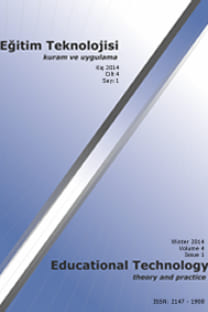İŞBİRLİKLİ ÖĞRENME ORTAMINDAKİ YARATICI ETKİNLİKLERİN ÖĞRENCİLERİN YARATICI VE ELEŞTİREL DÜŞÜNMELERİ İLE AKADEMİK BAŞARILARI ÜZERİNE ETKİSİ
yaratıcı düşünme, eleştirel düşünme, işbirliğine dayalı öğrenme, bilgisayar eğitimi, öğretmen adayları
-
creative thinking; critical thinking; cooperative learning; computer literacy course; prospective teachers ,
___
- Aslan, A. E. (1999). Adapdation of Torrance Test of Creative Thinking. International Conference on Test Adaptation Proceedings. George Town University, Washington D.C. Kongresinde Sunulmuş Bildiri.
- Aslan, A. E., & Puccio, G. J. (2006). Developing and testing a Turkish version of Torrance's Tests of Creative Thinking: A study of adults. The Journal of Creative Behavior, 40(3), 163-177.
- Aybek, Birsel. 2007. Konu ve Beceri Temelli Eleştirel Düşünme Öğretiminin Öğretmen Adaylarının Eleştirel Düşünme Eğilimi ve Düzeyine Etkisi. Adana: Çukurova Üniversitesi. (Yayınlanmamış doktora tezi)
- Bentley, T. (1996). Sharpen Your Team’s Skills in Creativity. United Kingdom: McGraw-Hill.
- Boden, M. A. (2004). The creative mind: Myths and mechanisms. New York: Routledge.
- Büyüköztürk, S. (2007). Deneysel Desenler, Öntest-Sontest Kontrol Grubu Desen ve Veri Analizi (2. Basım). Ankara: Pegem A Yayıncılık.
- Callison, D. (2000). Rubrics. School Library Media Activities Monthly, 17, 34-36.
- Carlan, V.,Rubin, R., & Morgan, B. (2005). Cooperative learning, mathematical problem solving, and Latinos. International Journal for Mathematics Teaching and Learning. http://www.cimt.plymouth.ac.uk/journal/morgan.pdf adresinden 10 Haziran 2014 tarihinde alınmıştır.
- Facione, N. C. &Facione, P. A. (1996). Externalizing the critical thinking in knowledge development and clinical judgment. Nursing Outlook, 96(44), 129-136.
- Facione, P. A.;Facione, N. C., &Giancarlo, C.A.F. (1998). The California Critical Thinking Dispositions Inventory. California: Academic Pres.
- Ennis, R. (1996). Critical thinking dispositions: Their nature and assessability. Informal Logic, 18(2), 165-182.
- Ennis, R. (2000). A super-stream lined conception of critical thinking. http://www.criticalthinking.net/SSConcCTApr3.html adresinden 09 Temmuz 2013 tarihinde alınmıştır.
- Gardner, H. (2007). Five minds for the future. Massachusetts, Boston: Harvard Business School Press.
- Hourcade J. J. &Bauwens J. (2001). “Cooperative Teaching: The Renewal of Teachers.”The Clearing House,74(5), 242-247.
- Howitt, D. &Cramer, D. (1997). An Introduction to Statics in Psychology. London: PrenticeHall
- Hudgins, B. & S. Edelman. (1986). Teaching Critical Thinking Skills To Fourth And Fifth Graders Through Teacher-Led Small Group Discussions. Journal Of Educational Research, 79(6), 333–342.
- Isaksen, S. G. &Parnes, S. J. (1985). Curriculum planning for creative thinking and problem solving. The Journal of Creative Behavior, 19(1), 1-29.
- Jenkins, J.R., Antil, L.R., Wayne, S.K., &Vadasy, P.F. (2003). How cooperative learning Works for special education and remedial students. Exceptional Children, 69 (3), 279-292.
- Johnson, D.W. & Johnson, F.P. (2006). Joining together group theory and group skills. Boston, MA: Pearson.
- Johnson, D.W & Johnson R. T. (1999). Learning togetherandalone: Cooperative, Competitive and Individualistic Learning (5th edition). Boston: Allynand Bacon.
- Karakuş, M. (2000). Alt-Sosyo Ekonomik Düzeydeki İlköğretim 2. Sınıf Öğrencilerinin Yaratıcılık Düzeylerine Yaratıcı Sorun Çözme Programının Etkisi. (Yayınlanmamış Yüksek Lisas Tezi). Çukurova Üniversitesi/ Sosyal Bilimler Enstitüsü, Ankara.
- Kramarski, B. &Michalsky, T. (2010). Preparing preservice teachers for self-regulated learning in the context of technological pedagogical content knowledge. Learning and Instruction, 20, 434-447.
- Kökdemir, D. (2003). Belirsizlik Durumlarında Karar Verme ve Problem Çözme. (Yayınlanmamış Doktora Tezi). Ankara Üniversitesi/Sosyal Bilimler Enstitüsü, Ankara.
- Kuhn, D. & Dean, D. (2004). Metacognition: A bridge between cognitive psychology and educational practice. Theory Into Practice,43(4), 268-273.
- Le Storti, A.,Cullen, P. A., Hanzlik, E.M., Michiels, J. M., Piano, L.A., Ryan, P.A., et al. (1999). Creative Thinking In Nursing Education: Preparing For Tomorrow’s Challenges. Nusing Outlook,47(2), 62–66.
- McGrath, J.P. (2003). The Relationship of Critical Thinking Skills And Critical Thinking Disppositions of Baccalaureate Nursing Students. Journal Of Advanced Nursing, 43 (6). 569-577.
- Mills, C. J. &Durden, W. G. (1992). Cooperative Learning and Ability Grouping: An Issue of Choice. Gifted Child Quarterly,36, no:1,11-16.
- Moore, T. (2004). The critical thinking debate: How general are general thinking skills? Higher Education Research and Development, 23(1), 3-18.
- Moore, B. &Parker, R. (2007). Critical thinking. United States: McGraw-Hill.
- Overton, J. Caines. (1993). An investigation of the effects of thinking skills instruction on academic achievement and the development of critical and creative thinking skills of second, fourth and sixth grade students (Doctoral Dissertation). Retrieved from ProQuest Digital Dissertations, Publication Number: AAT 9417153.
- Öner, S. (1999). İlköğretim Beşinci Sınıf Sosyal Bilgiler Dersinde Kubaşık Öğrenme Yönteminin Eleştirel Düşünme Ve Akademik Başarıya Etkisi. (Yayınlanmamış Yüksek Lisas Tezi). Çukurova Üniversitesi/ Sosyal Bilimler Enstitüsü, Ankara.
- Özçınar, H.N. (1996). Enhancing Critical Thinking of Preparatory University Students of English at Intermediate Level. Ankara: University of Middle East Technical. (Unpublished master's thesis).
- Özden, Y. (2005). Öğrenme ve Öğretme (7th ed.). Ankara: Pegem A Yayıncılık.
- Runco, M. A. (2007). Developmental Trends and Influences on Creativity. Creativity, 2007, 39-69.
- Sternberg, R. J. &O’Hara L.A. (1999). Creativity The Self and The Environment and Intelligence. USA: Cambridge University Press
- Sungur, N. (1997). Yaratıcı Düşünce ( 2nd Ed.). [Creative Thought]. İstanbul: Evrim Yayınevi.
- Torrance, E.P. (1968). Finding hidden talents among disadvantaged children. Gifted Child Quarterly, 12(3), 131-137.
- Veenman, S.,Benthum, N., Bootsma, D., Dieren, J. &Kemp, N. (2002). Cooperative Learning And Teacher Education. Teaching and Teacher Education, 18, 87-103.
- Williamson A. &Null J. W. (2008). Ralph Waldo Emerson’s Educational Philosophy as a Foundation ForCooperative Learning. American Educational History Journal, 35( 2), 381–392.
- ISSN: 2147-1908
- Yayın Aralığı: Yılda 2 Sayı
- Başlangıç: 2011
- Yayıncı: Tolga Güyer
KİŞİSELLEŞTİRİLMİŞ MATEMATİK PROBLEMLERİNİN AKADEMİK BAŞARIYA ETKİSİ
Yasemin DEMİRASLAN ÇEVİK, Sibel BARIN
SANAL ORTAMLARDA BİREYLERİN GÜVENİRLİĞİNİN, İNTERNET BAĞIMLILIK DURUMLARINA GÖRE İNCELENMESİ
Erkan TEKİNARSLAN, Ercan TOP, Melih Derya GÜRER, Ahmet YIKMIŞ, Mustafa AYYILDIZ, Alpaslan KARABULUT, Ömer SAVAŞ
SANALORTAMLARDABİREYLERİNGÜVENİRLİĞİNİNİNTERNETBAĞIMLILIKDURUMLARINAGÖREİNCELENMESİ
Yasemin DEMİRASLAN ÇEVİK, Sibel BARIN
Özcan AKGÜN, Ömer GÖKMEN, Ebru ALBAYRAK ÖZER, Zeliha DEMİR KAYMAK, Mehmet HORZUM, Mübin KIYICI
ÖĞRETİM SÜRECİNDE HİKÂYE ANLATMANIN TEKNOLOJİYLE DEĞİŞEN DOĞASI: DİJİTAL HİKÂYE ANLATIMI
Erkan TEKİNARSLAN, Alpaslan KARABULUT , Melih Derya GÜRER, Ercan TOP, Ahmet YIKMIŞ, Ömer SAVAŞ, Mustafa AYYILDIZ
